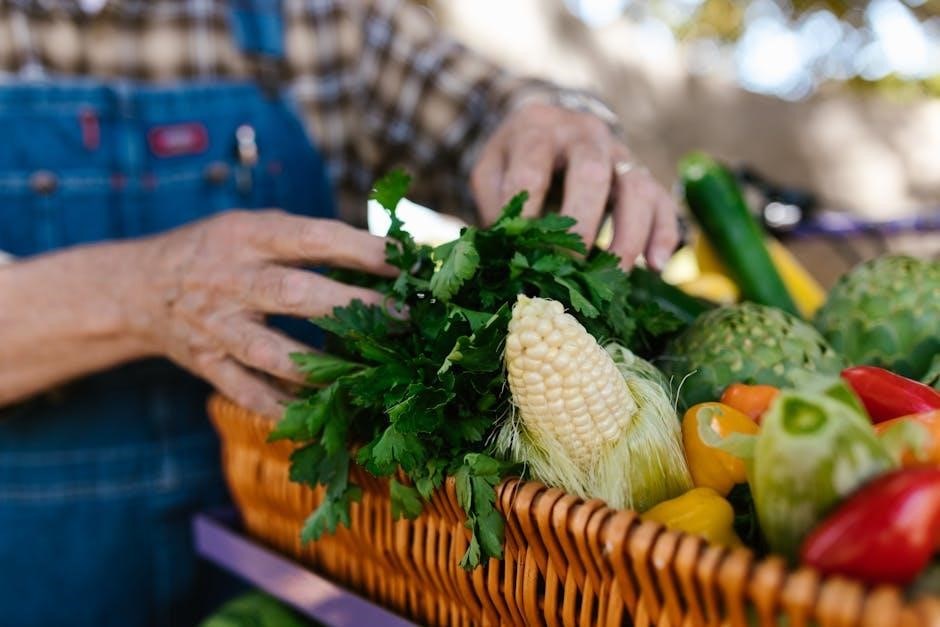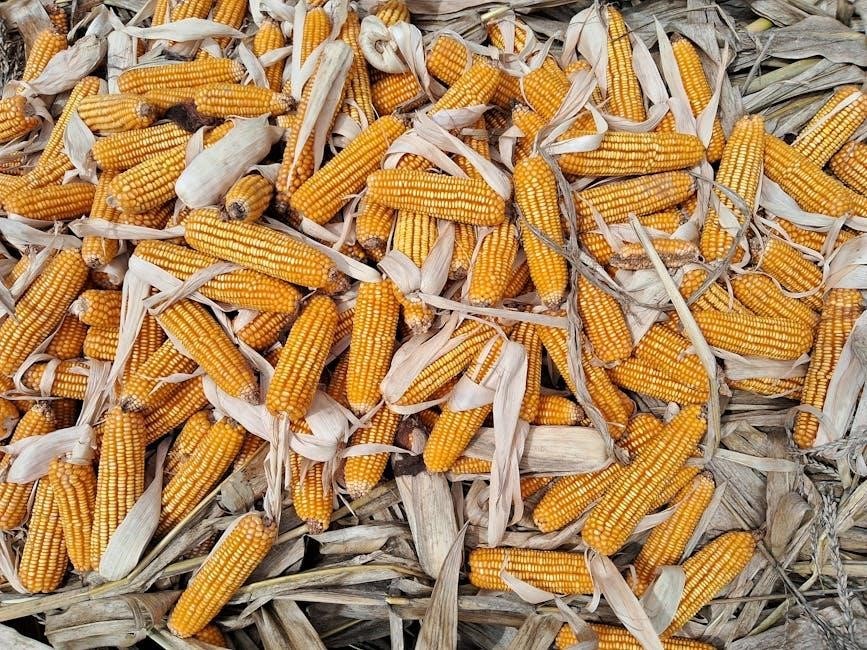Corn toss, also known as bean bag toss or Baggo, is a popular outdoor game where players throw bean bags onto a board with a hole. The objective is to score points by landing bags on the board or through the hole. It’s a fun, easy-to-set-up game perfect for backyard gatherings and events, suitable for all ages.
1.1 Objective of the Game
The objective of Corn Toss is to score points by throwing bean bags onto the board or through the hole. Points are earned when bags land and stay on the board (Woody) or pass through the hole (Cornhole). The goal is to accumulate more points than the opposing team by accurately tossing the bags. Strategy and precision are key to success.
1.2 Basic Rules and Gameplay
Corn Toss is played with two teams, either singles or doubles. Players take turns tossing bean bags underhand toward the opposing board. A toss is valid if the bag lands on the board or goes through the hole. Bags must come to rest naturally; knocking or moving bags is not allowed. The scoring is based on the final position of the bags after each round.
Equipment and Setup
Corn Toss requires two 4×2-foot boards with a 6-inch hole and eight 6×6-inch bean bags. The boards are placed 27 feet apart for standard play.
2.1 Cornhole Boards Dimensions and Features
Cornhole boards are typically 4 feet long and 2 feet wide, constructed from durable materials like wood. A central 6-inch diameter hole is positioned 9 inches from the top. The boards have a smooth, even surface to ensure consistent gameplay and accurate bag slides. They are designed to withstand outdoor conditions, making them ideal for backyard and competitive events.
2.2 Cornhole Bags Specifications and Requirements
Cornhole bags are 6 inches square, made of durable materials, and filled with 1 pound of plastic pellets or corn feed. Each bag weighs 14-16.25 ounces. Official bags must meet American Cornhole Association (ACA) standards to ensure consistency and fairness in gameplay. Bags are typically divided into two distinct colors for team identification, with four bags per team.
Scoring System
The scoring system is straightforward: 3 points for a cornhole (bag through the hole), 1 point for a woody (bag on the board), and 0 for a foul. Each toss is categorized into one of these outcomes, emphasizing accuracy and strategy to maximize points.
3.1 Cornhole (3 Points)
A cornhole is the highest scoring play, awarding 3 points. This occurs when a bean bag passes completely through the hole in the board. The bag must go through the hole cleanly, with no part of it remaining on the board or touching the ground. It’s a challenging but rewarding shot that can quickly turn the tide of the game.
3.2 Woody (1 Point)
A Woody earns 1 point and occurs when a bean bag lands and remains on the board without falling off or going through the hole. The bag must rest entirely on the board’s surface, not touching the ground or the hole. Multiple Woodies can add up, making them strategically important for steady scoring throughout the game.
3.3 Foul (0 Points)
A foul results in 0 points and occurs when a throw doesn’t meet game rules. This includes bags that miss the board, are thrown out of turn, or if a player steps over the foul line. Foul bags are removed from play, and no points are awarded for that toss, ensuring fair and regulated gameplay for all participants.

Rules of the Game
Corn toss rules begin with a coin toss to decide the first player. Players take turns pitching bags from the designated distance. The goal is to score points by landing bags on the board or through the hole.
4.1 Determining Who Throws First
The first player is typically decided by a coin toss. This ensures fairness and randomness at the start of the game. Before the game begins, each team or player flips a coin to determine who will throw first. The winner of the coin toss chooses their throwing order and lane setup, providing a clear and impartial way to initiate gameplay.
4.2 Pitching Distance and Lane Setup
The boards are positioned 27 feet apart, facing each other. Players pitch from their respective pitchers’ boxes, located on either side of the board. The distance ensures a fair challenge, while the lane setup allows for clear throwing paths. Proper alignment and spacing are crucial for maintaining consistent gameplay and fair competition among participants of all skill levels.
4.3 Turn Order and Timing
Players alternate turns, with each player throwing one bag per turn. A player must wait until the previous bag has come to a complete stop for at least 2 seconds before pitching the next one. This ensures fair play and maintains the flow of the game. Proper timing and order are essential for a smooth and enjoyable experience for all participants.

Mastering the Toss
Mastering the toss requires consistency and practice. Focus on grip, stance, and smooth throwing motion. Proper release and follow-through ensure accuracy and control, leading to better scores.
5.1 Grip and Stance
To master the grip, hold the bag firmly but not too tightly, with your hands positioned for control. Stand with feet shoulder-width apart, knees slightly bent, and body balanced. This stance provides stability, allowing for a smooth, consistent throwing motion and better accuracy when aiming for the board or hole.
5.2 Throwing Motion and Release
The throwing motion involves an underhand swing, stepping forward with your non-throwing foot. Swing your arm forward from the elbow, releasing the bag when it’s nearly parallel to the board. Aim for a smooth, controlled release to ensure accuracy and distance. Practice this motion to develop consistency and improve your toss precision over time.
5.4 Follow-Through and Consistency
Follow-through is essential for accuracy and control. After releasing the bag, extend your throwing arm fully, maintaining the direction of your toss. Consistency is key; practice the same motion repeatedly to develop muscle memory. Over time, this will help you achieve a reliable and precise throw, improving your overall performance in the game.

Common Penalties and Fouls
Common penalties include stepping over the line, touching the board, or invalid throws. Fouls result in zero points for that bag and potential disqualification if repeated.
6.1 Invalid Throws and Re-Throws
An invalid throw occurs when a player steps over the line, touches the board, or the bag doesn’t land on the board. Such throws result in zero points and potential disqualification if repeated. Re-throws may be permitted under specific circumstances but must adhere strictly to the rules to avoid further penalties.
6.2 Interference and Unfair Play
Interference involves any action that disrupts an opponent’s throw or alters the position of bags on the board. Examples include touching the board during a toss or distracting a player. Unfair play, such as moving a bag after it lands, can lead to penalties, loss of points, or even disqualification from the game.
Strategies for Success
Develop a consistent tossing technique, focus on accurate aim, and strategize to block opponents’ bags. Practice adapting to wind and distance for better performance.
7.1 Aiming for the Hole vs. the Board
Aiming for the hole yields higher points but requires precision, while targeting the board is more achievable and still awards points. Players must weigh risk and consistency, focusing on the hole for maximum scoring potential while ensuring the bag lands on the board to secure points if the hole is missed.
7.2 Blocking and Knocking Off Opponents’ Bags
Strategically placing your bags to block opponents or knock their bags off the board can significantly impact the game. This tactic disrupts their scoring opportunities while protecting your own bags. Mastery of this technique requires precise throws and a keen understanding of bag placement, making it a crucial skill for competitive play and maximizing your advantage.

Advanced Techniques
Mastering spin, curve shots, and adjusting for wind and distance enhances accuracy and control, allowing players to outmaneuver opponents and score consistently in challenging conditions.
8.1 Spin and Curve Shots
Advanced players use spin and curve shots to control bag trajectory. By adjusting grip and release, players can create side spin for curves or backspin to stop bags instantly. Spin shots help navigate wind, while curve shots bypass blockers. Practicing these techniques enhances precision and strategy, allowing for better bag placement and higher scores in competitive play.
8.2 Adjusting for Wind and Distance
Wind and distance significantly impact corn toss accuracy. To compensate for wind, players may adjust their throwing angle or strength. For longer distances, a firmer grip and more powerful toss are needed, while shorter distances require precision and control. Understanding environmental conditions and adapting your technique ensures consistent performance and better scoring opportunities during gameplay.

Variations of the Game
Corn toss offers exciting variations, including singles and doubles play, allowing for competitive or casual fun. Time-based and point-based games add unique twists, catering to different preferences.
9.1 Singles vs. Doubles Play
Singles play involves two players competing individually, while doubles play features four players divided into two teams. Doubles allows for strategic teamwork, with partners coordinating throws and tactics. Both formats enhance the game’s social aspect, accommodating different group sizes and preferences. The dynamic shifts between individual skill and collaborative strategy, making each variation uniquely engaging.
9.2 Time-Based vs. Point-Based Games
Corn toss can be played as time-based or point-based games. Time-based games set a specific duration, with players scoring as many points as possible within the time. Point-based games aim to reach a target score, traditionally 21 points, by landing bags on the board or through the hole. Both formats add excitement and flexibility to the game.
Corn toss is a fun, accessible game for all skill levels. Regular practice improves accuracy and technique. Keep playing to master your toss and enjoy the game with friends!
10.1 Tips for Improving Your Game
To improve at corn toss, focus on consistency in your grip, stance, and throwing motion. Practice your follow-through and aim for the center of the board. Stay relaxed, keep your arm swing smooth, and pay attention to distance and wind conditions. Regular practice helps refine your technique and builds confidence. Keep experimenting with different throws to find what works best for you.
10.2 Encouragement to Practice and Play
Corn toss is a game that combines skill and fun, making it enjoyable for players of all levels. Regular practice builds confidence and improves technique, while playing with others fosters camaraderie. Whether at a backyard gathering or a competitive event, corn toss brings people together. Embrace the challenge, enjoy the process, and keep tossing—every throw brings you closer to mastery and memorable moments.

